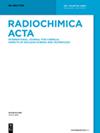乌兹别克斯坦卡塔库尔干水库地下水及附近地区天然放射性核素和重金属浓度的测定
IF 1.7
3区 化学
Q4 CHEMISTRY, INORGANIC & NUCLEAR
引用次数: 0
摘要
摘要 我们对卡塔库尔干水库以及邻近的水井和钻孔进行了全面评估,以测量天然放射性核素、重金属和相关放射性危害的浓度。我们使用 NaI(Tl)晶体闪烁伽马能谱仪测定了水和沉积物中的放射性核素含量。重金属分析则采用了电感耦合等离子体质谱法(ICP-MS)。结果显示,水库水中 226Ra(0.8 Bq/L)、232Th(0.4 Bq/L)和 40K(0.4 Bq/L)的放射性核素浓度均在世界卫生组织(WHO)规定的范围之内。相比之下,深井水样本中的 226Ra 浓度较高(1.5 Bq/L)。沉积物样本的放射性核素水平符合联合国辐射防护委员会的指导方针。钡是最显著的重金属,浓度为 68.08 微克/升。虽然大多数辐射危害指数都保持在安全范围内,但伽马指数却达到了 1.057 Bq/kg。我们的研究为水质评估提供了宝贵的数据。所述方法可用于其他水库研究。建议进行定期监测,以进行持续的安全评估,并建议对生物样本进行进一步研究,以加深对水库生态系统健康状况的了解。本文章由计算机程序翻译,如有差异,请以英文原文为准。
Determination of natural radionuclides and heavy metal concentrations in the groundwater and adjacent areas of the Kattakurgan reservoir, Uzbekistan
Abstract We conducted a comprehensive assessment of the Kattakurgan reservoir, alongside adjacent wells and boreholes, to measure the concentrations of natural radionuclides, heavy metals, and associated radiological hazards. Using NaI(Tl) crystal scintillation gamma spectrometers, we determined radionuclide levels in water and sediment. Inductively coupled plasma mass spectrometry (ICP-MS) was employed for heavy metal analysis. Our results showed radionuclide concentrations in reservoir water for 226Ra (0.8 Bq/L), 232Th (0.4 Bq/L), and 40K (0.4 Bq/L) were within the limits set by the World Health Organization (WHO). In contrast, deep well water samples showed elevated 226Ra concentrations (1.5 Bq/L). Sediment samples’ radionuclide levels were in line with UNSCEAR guidelines. Barium was the most notable heavy metal, with a concentration of 68.08 μg/L. While most radiation hazard indices remained within safety limits, the gamma index recorded a value of 1.057 Bq/kg. Our research provides valuable data for water quality assessment. The methods described can be applied to other reservoir studies. Regular monitoring is recommended for continuous safety evaluation, and further studies on biotic samples are suggested to enhance understanding of the reservoir’s ecosystem health.
求助全文
通过发布文献求助,成功后即可免费获取论文全文。
去求助
来源期刊

Radiochimica Acta
化学-核科学技术
CiteScore
2.90
自引率
16.70%
发文量
78
审稿时长
6 months
期刊介绍:
Radiochimica Acta publishes manuscripts encompassing chemical aspects of nuclear science and technology.
 求助内容:
求助内容: 应助结果提醒方式:
应助结果提醒方式:


